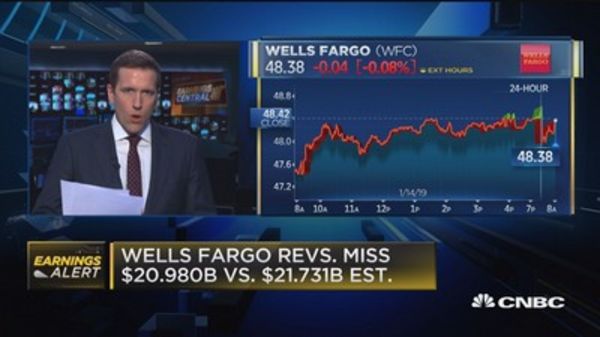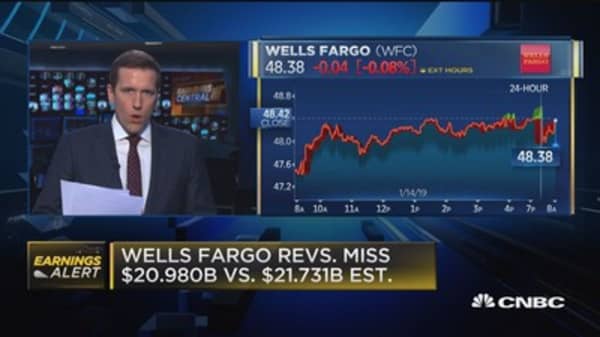Wells Fargo will continue to operate under a Federal Reserve restriction on its growth through the end of this year, its CEO said on Tuesday, longer than previously estimated.
Shares of the San Francisco bank fell nearly 3 percent on Tuesday.
Earlier, Wells reported fourth quarter profit of $1.21 a share, beating expectations. But revenue of $20.98 billion for the quarter fell short of expectations and the bank reported declines in all three of its main businesses.
Profit of $6.1 billion was down from $6.2 billion recorded in the fourth quarter of 2017, and revenue was 5 percent lower than the prior fourth quarter as well. Wall Street analysts polled by Refinitiv had expected profit of $1.16 a share on revenue of $21.73 billion.
Wells Fargo is still working through its regulatory issues after the Federal Reserve reportedly rejected the bank’s plan to prevent more consumer abuses. On Tuesday, CEO Tim Sloan said the bank would continue to operate under a Fed-imposed cap on asset growth through the end of this year, months longer than he previously indicated in December.
The bank is also in the midst of a cost-cutting plan, including the elimination of up to 10 percent of its employee head count. On Tuesday it said it met its 2018 expense target and was on track to meet its 2019 goal.”We have made meaningful improvements to how we manage risk across the company, particularly operational and compliance risk,” Sloan said in a statement Tuesday.
Revenue in consumer and small-business banking fell 2 percent, to $11.5 billion, primarily because of lower mortgage banking income and decreased market-sensitive revenue, partially offset by gains from the sale of branches and certain mortgage loans. Revenue from providing banking and other services to corporations dropped 7 percent, to $514 million after the sale of some businesses and lower market-sensitive revenue. Revenue from wealth management fell 9 percent, to $3.9 billion.
For full-year 2018, Wells Fargo revenue declined 2 percent, to $86.4 billion, while profit of $22.39 billion was up about 1 percent.
Problem loans decreased 4 percent from the third quarter and nonaccruing commercial and consumer loans also fell. But Octavio Marenzi, CEO of financial consulting firm Opimas, said, “In an environment of increasing interest rates, we are likely to see some erosion in this credit quality in coming quarters, as well as increasing the bank’s interest expense.”
Investors are listening for what bank executives say about the direction of interest rates this year after four Fed rate hikes in 2018. They are also likely looking for guidance on 2019 revenue expectations given a probable slowdown in U.S. economic growth. Rising short-term rates have narrowed the profits banks make on key activities like lending, and revenue from bond trading was lackluster at the end of last year.
[“source-cnbc”]
























































